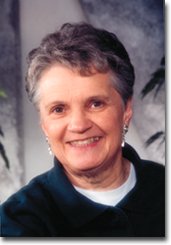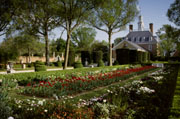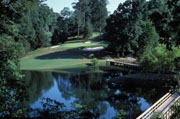
Colonial Williamsburg - The Birthplace of a Nation
She recounts in dramatic tones, long-ago events and the colourful people who shaped their lives. Her fascinating stories are told with intimate detail and without a note in sight. To Martha, Williamsburg is enchanted ground and she wants her guests to feel the enchantment also. Mary’s reputation as a well-informed, skilled actress has secured her position as an excellent interpretive guide, highly sought after for her clever presentations.
In Colonial Williamsburg there is nothing unusual about an encounter of this kind. At the Kimball Theatre, Thomas Jefferson (Bill Barker) spoke about his life and work in the new colony. During question period a young lad from Salt Lake City asked him about his views on slavery and Jefferson quickly replied that slavery is wrong.
The lad asked, “ Then why do you have slaves?” to which Jefferson apologetically replied that it was an economic necessity.
When wandering along Duke of Gloucester Street, it doesn’t take long to realize that all the costumed interpreters are skilled actors. They have performed these roles for years and never stray from the 1770s.

Dozens of interesting programs allow visitors to glimpse life on the eve of revolution. Patrick Henry was all fired up at the Palace Gardens trying to incite the colonists to throw off the British yoke. His most famous speech came a year later, incensed because of the Stamp Act, when he thundered in the House of Burgesses “…Is life so dear or peace so sweet as to be purchased at the price of chains and slavery? I know not what course others may take, but as for me, give me Liberty of give me Death!”

Colonial Williamsburg was once the capital of Virginia and the Historic Area has been restored to its 18th century charm, protected from modern intrusion by 3,000 acres of greenbelt. This is how it looked in 1765 when Britain’s relationship with her 13 American Colonies had begun to deteriorate. The imposed taxation on tea, led to the Boston Tea Party in 1774. With tensions escalating, Governor Dunmore ordered British marines to seize the gunpowder from the Magazine and that caused emotions to reach a fever pitch. On June 8th, 1775, Lord Dunmore and his family fled to a warship in the York River, ending British rule in Virginia, the wealthiest of all the colonies.
Patrick Henry became the first governor of Virginia in 1776, and moved into the Palace. Jefferson succeeded him and the capital was moved to Richmond in 1779. The British attacked the colonies starting the Revolutionary War that lasted from 1775 to 1783.
The historic area of Williamsburg comprises over 300 acres with 88 original structures and hundreds of reconstructed buildings. Some of the most important are the Wren Building at the College of William and Mary (1695), the Bruton Parish Church (in continuous use since1715), The Governor’s Palace (1722), the Raleigh Tavern (1717) with a bust of Sir Walter over the doorway, the Magazine (1715), the Public Jail, the Capitol (1701), and the Hospital for the Mentally Ill (the first in North America). It is a mile-long walk along Duke of Gloucester Street, the main street of this charming little village. The Civil War, (1861-65) saw Williamsburg devastated again. Fighting for the South, many buildings were destroyed and the town was often filled with the wounded and dying.
Colonial Williamsburg, the nation’s largest outdoor living history museum, has been restored following diligent research. This huge undertaking was accomplished by the enthusiasm of Rev. William Goodwin, pastor of Bruton Parish Church and the generosity of John D. Rockefeller Jr. When President Franklin D. Roosevelt visited in 1934 to celebrate the first phase of the restoration he called the reconstructed Duke of Gloucester Street, “the most historic avenue in America”.

The most luxurious accommodations are in the Williamsburg Inn, which was opened in 1937 by the Rockefellers. It is world-renowned for its hospitality, recreational facilities and services for its guests. Regency-style furnishings, silk window treatments and spacious individual character guest rooms are complete with exquisite marble bathrooms. As the years pass the guest register lengthens including Elizabeth II, Sir Winston Churchill, many U.S. presidents, the Emperor and Empress of Japan, kings and queens of Greece, Thailand, Morocco, Belgium, Jordan and Sweden. Breakfast in the Regency Room is included and that is an experience fit for a king!

After total immersion in the 18th century, it is very easy to become totally immersed in golf. The Golden Horseshoe Golf Club is only a chip shot away. For a real challenge try the Gold Course, designed by Robert Trent Jones Sr. Equally beautiful and friendlier, (especially for ladies) is the Green Course, designed by his son, Rees Jones. The Spotswood serves as a warm-up for resort guests anticipating the demands of the Gold and Green Courses. GOLF Magazine called it the “best short nine-hole course in the country,”
The Tazewell Club Fitness Center offers an indoor lap pool, sauna, steam room, whirlpool, aerobics studio, exercise room, sports shop, massages and herbal wraps.
If you go
Williamsburg is located 150 miles south of Washington, DC. It is served by international airports at Richmond, Norfolk and Newport News. The town is accessible by Interstate 64, exit 238.
The Historic Town Area is 301 acres, one mile long and 1/2 mile wide. Colonial Williamsburg Hotels are located directly adjacent to the Historic Area and breakfast is included. Five hotels provide 1,073 rooms and suites and 11 restaurants with rates from $278 to $73, per person, per night. The Hotel Guest Pass provides a discounted admission good for the length of the stay. A Freedom Pass costs $49, valid for one full year. Hotel guests have priority tee times at the Golden Horseshoe Golf Club’s three courses. Start at the Visitor Center, followed by an orientation tour. Special assistance, wheelchair rental and accessible bus service are available for those with disabilities. Watch the 15-minute film Williamsburg - The Story of a Patriot. Colonial Williamsburg and the Golden Horseshoe Golf Club are open 365 days a year
Dining
The Regency Room in the Williamsburg Inn is acclaimed for its regional cuisine.
Four historic dining taverns serve colonial fare, while balladeers entertain with the music of the era. Waiters and waitresses dress in colonial attire.
For reservations and information call 1-800-HISTORY or www.colonialwilliamsburg.com.